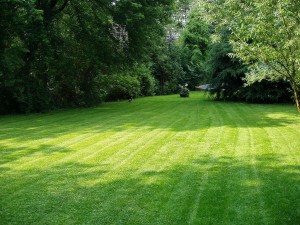Want your lawn to look greener longer? Planting cool weather grasses can give your turf a second life, taking over as warm weather grasses become dormant. Not only do these plants grow in colder weather, they stay green when they’re in hibernation, keeping your lawn looking good through the winter.
What Makes Cool Weather Grass Different?
These grasses sprout when temperatures are 65 degrees or lower, so they start growing as warm weather grasses are heading toward dormancy, then come back earlier in the spring. Cool weather varieties don’t become dormant until temperatures get much lower, and when they do, they still tend to remain green. Planting these grasses can help keep your lawn looking good longer through the year, particularly in the colder climates found in the northern half of the U.S.
Selecting a Variety
There are several varieties of grass that fall into the cool weather category: Kentucky bluegrass, perennial rye and several types of fescues. Fescue has traditionally been divided into tall and fine types, but new turf-type tall varieties have blurred the line with traits of both tall and fine grasses.
Bluegrass is a creeping grass that uses runners like most warm season grasses. This makes it more prone to thatch buildup. It needs open sun and plenty of water to thrive, but it has a fine texture, giving it the best ground coverage.
Fescue and ryegrass are bunch grasses that spread from a crown. These grasses require a high mowing height to keep the blades from cutting into the crown, usually around 2.5-3 inches.
Tall fescue has deep roots, making it drought-resistant, while its thick leaves are wear-resistant, making it a great choice for high-traffic areas. Newer varieties are finer, providing better coverage for a more even finish. For the best looking lawn, look for a variety made for turf, not pasture.
Fine fescue doesn’t handle wear, but it can withstand dry, shaded areas as well and cold better than any other cool season grass.
Perennial ryegrass works well in moist soil that doesn’t experience extreme temperatures. It germinates quickly, but won’t last as long as other cool season grasses. The crowns are shorter than fescue so it can be mowed down to a height of 1.5-2.5 inches.
It’s common to find seed blends to get full lawn coverage over the longest time period. Ryegrass sprouts first followed by bluegrass, while tall fescue covers high traffic areas and fine fescue covers shaded areas while filling in around other varieties for higher density.
Seeding
The best time for seeding these grasses depending on the blend and your local climate; for the northern half of the U.S, the best time falls somewhere between early September and late October. Ryegrass can also be seeded in early fall in the southern half of the country to boost warm season grasses.
The seeds need to make contact with the soil to germinate. Aerate and dethatch the lawn before laying down seed; if you have an overseeder, make a pass without seeding to pull up the thatch layer. The grass should be cut no higher than two inches to ensure the seeds have maximum ground contact, and the soil needs to be moderately moist to keep the seeds stick to the surface.
The seed producer will have a recommended density for the seed you purchased. With a Billy Goat overseeder, getting the right drop rate is simply a matter of setting the lever on the hopper.
Getting the Grass to Grow
The soil needs to stay moist for the grass to germinate. To maintain moisture, lightly sprinkle water on the lawn several times a day instead of watering all at once. The existing grass should provide enough coverage to protect the new seeds, but bare soil should be raked lightly to cover the seeds.
Seeding should coincide with fall fertilizing. Re-balance the minerals based on the results of a soil test, keeping in mind that new seeds need phosphorus near the surface for optimum growth. While other minerals will leach through the soil, phosphorus stays put, so it needs to be within reach of new, shallow roots.
Get Your Billy Goat Equipment Ready for Fall Lawn Care
From overseeders to aerators, if it’s Billy Goat, you can get parts for it at www.billygoatparts.com. We’re not just a Billy Goat dealer, we’re also a certified dealer for Kohler, Honda, and Briggs & Stratton, so we can supply you with parts for both your equipment and the motors that power them. We ship across the U.S. and Canada.

